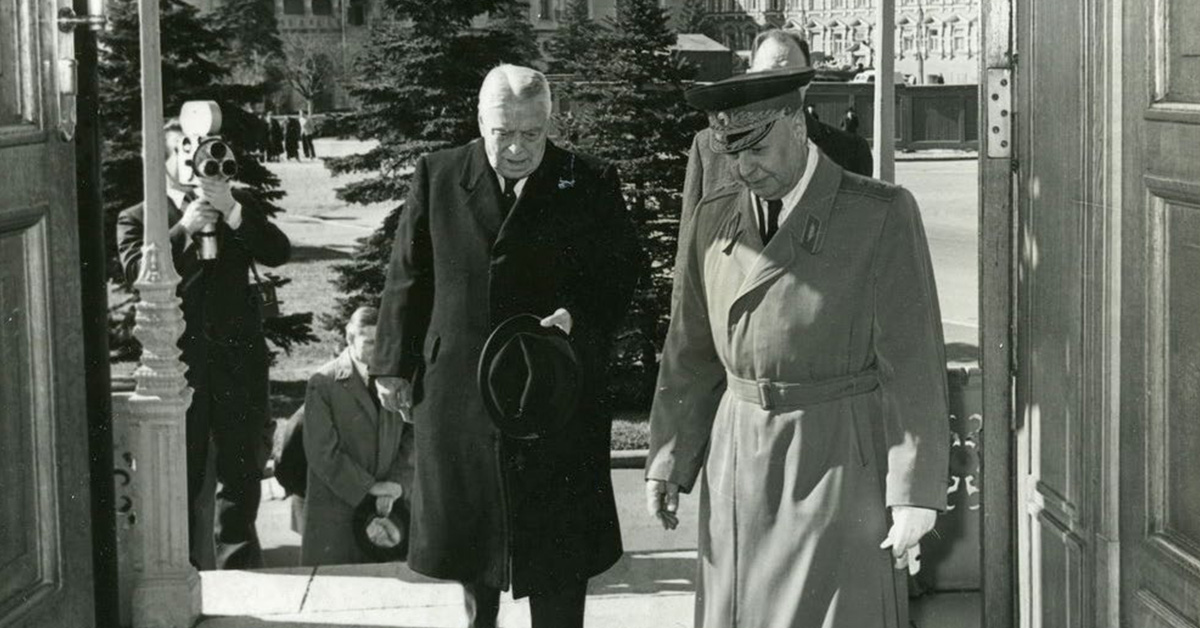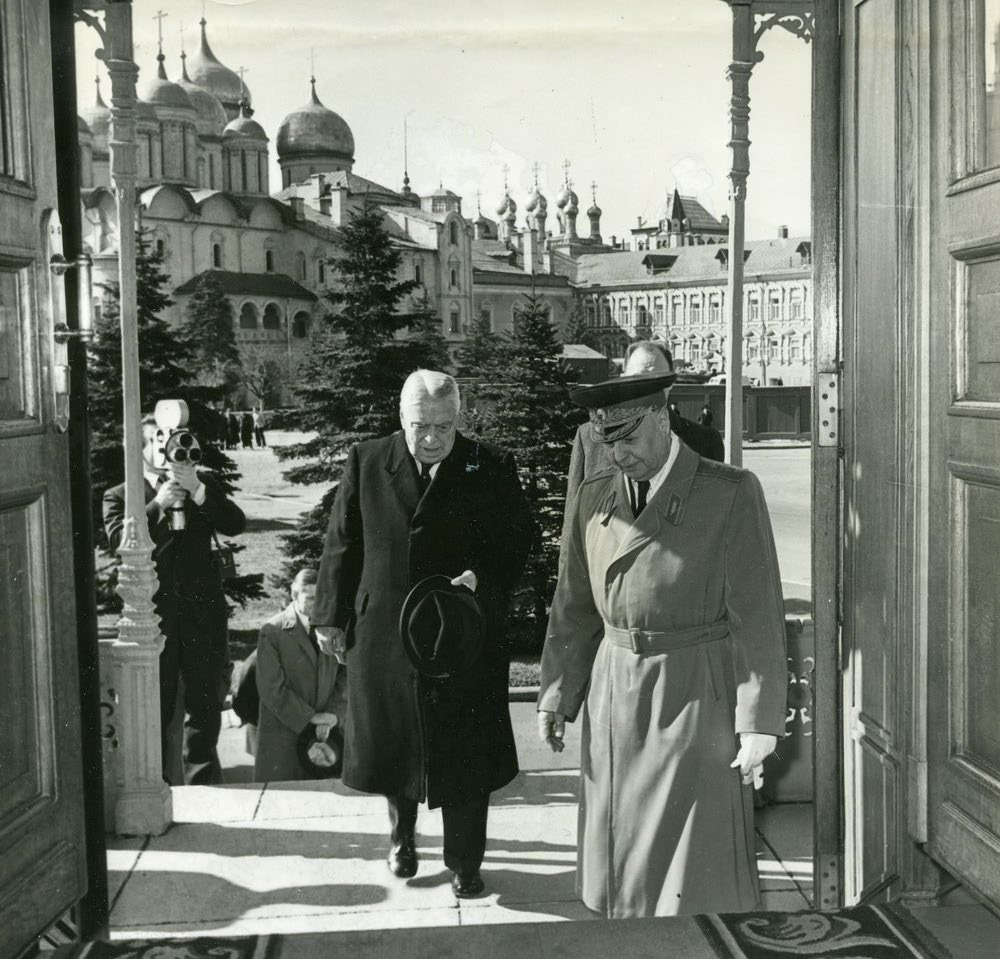
BACKSTORY

Former Prime Minister Walter Nash enters the Kremlin 1937–1939. Nash was in Europe to conduct trade negotiations for Michael Joseph Savage’s Labourled government. Photo: Archives New Zealand Te Rua Mahara o te Kāwanatanga.
The Northern Bear
New Zealand’s relationship with Russia has been characterised by instability — cycling between friend and foe, the nation and its citizens have often become a symbol of our own fears and anxieties.
By Scott Hamilton
In 1885 Russia invaded New Zealand. A warship named the Hinemoff, steered by a Captain Fairchildoffsky, steered into Waitematā Harbour, eluding shots from coastal batteries. Russian marines landed, and stormed the old colonial fort at Albert Park, where they raised their flag.
The ‘Russians’, though, were soldiers from Whangārei, the Waikato and the Coromandel. The Hinemoff was actually the Hinemoa, a government steamer that had been renamed for the occasion. Fairchildoffsky was usually known as Fairchild.
The ‘Russian invasion’ was an enormous war game, organised by George Whitmore, the head of New Zealand’s military. Crowds gathered on the volcanoes of Devonport to watch the game’s finale, the destruction of a Russian cruiser by a live action mine. This ‘cruiser’ was not the Hinemoa, which had been moved to safety, but a raft made with casks. As it exploded, a column of water a hundred feet high rose into the air. The crowds cheered from their hilltops.
Auckland’s was only one of a series of war games staged in 1885. In town after town, Russian attacks were simulated and defeated. In 1885 Russia and Britain were arguing about control of Afghanistan, and many Pākehā feared that raids by Russian ships were imminent.
Fear of Russian marauders was not new in the colony. Since Britain had fought Russia in the Crimean War of the mid-1850s, Pākehā had despised and worried about “the northern bear”. In 1873 David Luckie, a newspaperman and advocate of stronger defences against Russian attack, ran a hoax report of a Russian raid on Auckland on the front page of his Daily Southern Cross. Luckie told his readers that a Russian ironclad called the Kaskowiski — ‘cask of whisky’ — had landed at Auckland, and discharged marines. The mayor and other prominent citizens had been taken captive; the invaders wanted a ransom in gold.
Although Luckie provided clues that his report was a hoax, it nevertheless terrified many Aucklanders. Coaches began to flee the town; families hid their jewellery beneath floorboards. In the years after the hoax, huge guns were placed on Maungauika North Head, and a minefield was strewn across the harbour. Similar defences against the Russians were created in other port towns.
Russia had little presence in the South Pacific — unlike Britain, France and Germany, it had never sought to colonise the region’s islands — but it was the foreign power most feared by Pākehā.
In the 19th century Russia was ruled by an absolute monarch called the tsar, who tolerated no criticism. Great intellectuals and writers like Pushkin and Tolstoy were persecuted for their irreverence. Up until 1861, millions of rural Russians were serfs. They were owned by the lords of great estates, and forbidden to leave these estates. Even after their emancipation from slavery, Russia’s peasants remained very poor and mostly illiterate. Russia’s empire expanded eastwards in the 19th century, as the tsar’s armies conquered one indigenous people after another. Russia colonised all of Siberia, and established fortified ports on the Pacific.
A few refugees from the tsar reached New Zealand. Bernard Lichtenstein was the rabbi of Dunedin’s Jewish community in the 1870s; he had fled the Russian state’s anti-semitism.
But Pākehā comments about Russia went beyond legitimate criticism of the tsar and his state, and denigrated Russians as an inferior race. Most colonists regarded Europeans as the most civilised, the most ‘advanced’ human beings. Although their country existed partly inside Europe, Russians were considered “backward”, “barbaric” and “Asiatic”. Russia was then, as it is now, a very diverse country, including scores of ethnic groups, from pale-skinned Slavs to darker-skinned Kalmykians, who descended from Tibetan migrants and practised Buddhism, to the indigenous Siberian peoples, who were relatives of the first colonists of America.
But New Zealand’s colonial politicians and newspaper tended to lump all Russians together. They were called “Mongols” and “Tatars”, and their armed forces were likened to the hordes of Genghis Khan and Attila the Hun. Although most Slavic Russians were Christians, Pākehā ridiculed their “idolatorous” icons, “dirty” priests and “superstitious” rituals.
George Whitmore, the organiser of the war games of 1885, had fought against the Russians in the Crimean War, and then battled Māori fighters Tītokowaru and Te Kooti in the bush of Te Ika a Māui. In 1869 Whitmore had led a genocidal invasion of the Ureweras, burning Tūhoe kāinga and pulling up plantations in an effort to cause mass starvation. Whitmore hated Māori, and he hated Russians. Both, for him, were alien, non-European people: dangerous barbarians.
Crowds gathered on the volcanoes of Devonport to watch the war game’s finale, the destruction of a ‘Russian cruiser’ (a raft made of casks) by a live action mine.
Russophobia was encouraged by many politicians. British troops had left New Zealand in 1870, and the colonial state had little money to pay for defence. By creating hysteria about Russian invaders, politicians hoped to force Britain into keeping soldiers and ships in its colony, and perhaps into paying for coastal defences. Government ministers often leaked ‘exposs’ of Russian aggression to newspaper editors like Luckie.
In 1904 a real Russian war began in the northern Pacific. Tsar Nicholas II fought Japan over control of northern China and Korea. Russian ships were sunk, and Russian forts on the Pacific were blockaded or attacked. By the second half of 1905 it was clear that Russia had lost the war, and a revolution was threatening the Tsar’s rule. Peasants seized land from feudal lords. Workers seized factories, and formed soviets, or councils, to run them. Nicholas II ended the revolution by establishing a parliament with limited powers and by executing 12,000 of his enemies.
New Zealand’s response to the 1905 revolution reflected our Russophobia. There was little enthusiasm for the revolutionaries; Russians were regarded as constitutionally incapable of enjoying freedom and democracy.
During World War I Russia and Japan fought alongside the British Empire. The racialised denigration of Russians was transferred, for a few years, to Germans. Newspapers that had previously promoted Germany as a part of civilised Europe began to refer to Germans as the “Mongols” or “the Red Indians of Europe”. They nicknamed Germans ‘Huns’, in reference to Attila’s hordes. An anti-German riot in Gisborne trashed businesses whose owners had Teutonic-sounding names.
After the Bolshevik revolution in October 1917, though, Russophobia returned in the guise of anticommunism. New Zealanders tended to conflate the Soviet Union with Russia, ignoring the nations inside it like Ukraine, and to regard all Russians as “red barbarians”. The Soviet Union’s supporters in the local Communist Party were frequently arrested and charged with distributing seditious literature. Anti-communist feeling reached a peak after Hitler made a treaty with Stalin at the beginning of World War II. In 1940 the Labour government banned the People’s Voice, the newspaper of the Communist Party, and sent police to raid and destroy the party’s national headquarters. The party was forced to publish an illegal paper from secret locations. One printing press was found in a lava cave in Papatoetoe.
Everything changed after Hitler invaded the Soviet Union in the middle of 1941. The Soviets were now an ally, and as they stopped and then turned back the hitherto invincible German army, New Zealanders swapped Russophobia for Russophilia. Communist Party membership exploded, and it became fashionable to display Soviet flags. In 1943 New Zealand celebrated Red Army Day. Mayors and other leading citizens gathered in halls beneath the sickle and hammer to sing “The Internationale”, and Prime Minister Fraser made a radio broadcast in which he praised Stalin as a “great leader”.
But the enthusiasm didn’t last long. Only five years later, in 1948, Fraser told the Labour Party’s national conference that “the allegiance of the communist is not to New Zealand”, and said that the Soviet Union was “permanently at war” with the West. The Cold War had begun, and Russophobia had returned.
New Zealanders were once again worried about the possible presence of hostile Russian vessels in their waters. In 1948 Walter Ashton, a Communist Party member and the outgoing head of the Auckland Trades Council, disappeared after parking his car near Piha beach. Ashton had been dipping into union funds to pay his gambling debts; his successor was sure to discover this crime. But rather than accept that Ashton had committed suicide, many New Zealanders believed he had been picked up by a Soviet submarine. Questions were asked in Parliament as well as by the media.
Russophobia was still a force in 1975, when Rob Muldoon’s National Party ran a popular TV advertisement during the year’s general election campaign. The ad was a cartoon that showed a group of Cossacks — a Russian ethnic minority known for their skills on horseback and their role as cavalry in wartime — dancing in the midst of a New Zealand city. Muldoon argued his Labour Party opponents wanted to turn New Zealand into a communist state. He won the election in a landslide.
Since the collapse of the Soviet Union in 1991, New Zealand has been able to develop relationships with former Soviet states like Ukraine. The Ardern government has rightly condemned the invasion of Ukraine, and the brutal deeds of Putin’s forces. A global movement of solidarity with Ukraine has quickly developed. But there are signs that the Russophobia of old has not died. Many critics of the war have taken to calling not only Russian soldiers but Russians in general ‘Orcs’. An image that shows Putin as a new Genghis Khan, riding a horse amid his horde, has been widely circulated on social media. Russian New Zealanders have complained of abuse. We should remember that Russians are victims of Putin’s rule, just as they were victims of the tsars, and hope that they can free themselves.
Scott Hamilton is an historian and writer living in Auckland.
This story appeared in the May 2022 issue of North & South.


